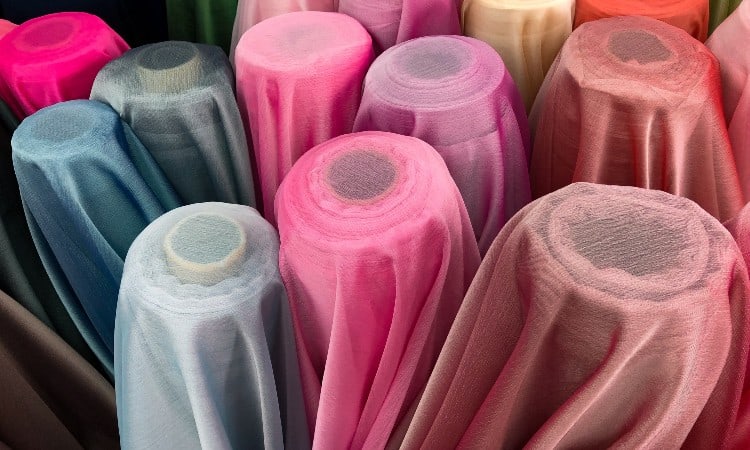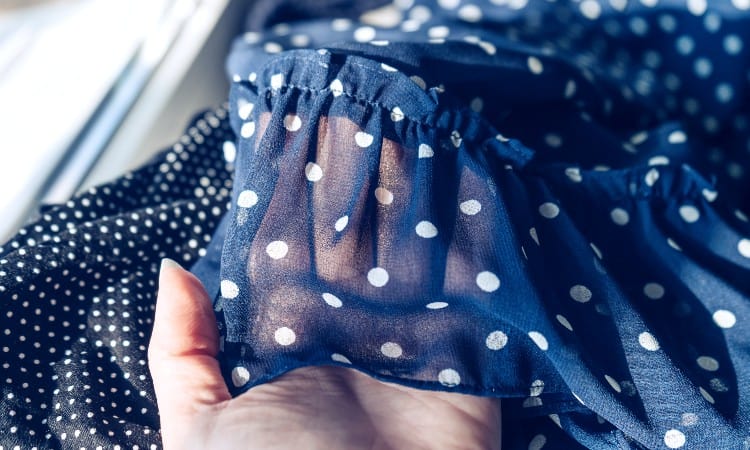When the summer heat rolls in and temperatures rise, we all begin looking for creative ways to beat the heat. Clothes made of breathable fabrics can help to keep you cool, which is why many designers use chiffon to make blouses and flowy summer dresses. But shoppers who are unfamiliar with chiffon may wonder is chiffon stretchy and comfortable to wear for everyday activities.
Chiffon fabric can be stretchy if its fibers are blended with materials designed to stretch, like spandex, lycra, or elastane. It will not stretch if it is made with only a single fiber type like polyester, silk, or cotton.
In this article, we’ll discuss the different varieties of chiffon and whether they are stretchy enough to keep you comfortable. We’ll also explain how to stretch your chiffon without damaging it, and we’ll provide tips on how to use this fabric in your next sewing project.

Is Chiffon Stretchy?
Chiffon is a stretchy fabric, except for the times when it isn’t. This response might seem a little confusing, but figuring out the answer to this question depends on what type of chiffon you are talking about. The overall stretchiness of this fabric comes from the materials it is made of and how it is woven.
The fibers in chiffon fabric are woven in a mesh-like weave, which is what gives the fabric its sheer appearance and lightweight feel. The fibers are arranged into S or Z shapes, which creates an open weave that gives it some natural stretch.
Even though chiffon has some natural give, some varieties contain added fibers to make them extra stretchy. This includes fabrics that have additions such as spandex, lycra, or elastane. Adding these fibers to the fabric can give some chiffons a pliable, more spandex-like feel.
On the other hand, chiffon that is woven with fibers that are meant to hold their shape will not stretch. This can include varieties made from polyester, silk, cotton, or even nylon. These fibers will strengthen the fabric, but will also prevent it from having anything more than a slight give.
Does Polyester Chiffon Stretch?
Polyester by itself is a fabric that does not like to stretch. It is a strong fiber that tends to hold its shape, meaning that chiffon made with 100% polyester will not be stretchy. With some chiffon clothing or fabric, you may see on its label that it is made with a polyester blend. If that blend contains a stretchy material like spandex, then the fabric will be able to stretch a little. Keep in mind, however, that polyester chiffon will never be a fabric that stretches a lot.
How to Stretch Chiffon

Chiffon can be very tricky to work with, and whether or not you can stretch it will depend on what it is made of. For chiffon that is made with non-stretch fabrics like polyester or silk, your fabric may rip or even shrink rather than stretch. Only try these tips with a chiffon fabric that has spandex or other stretchy materials added to it.
To stretch these types of chiffon, wet the fabric until it is damp. You can then lay the fabric flat and gently stretch it to your desired dimensions. You will need to use heavy objects to hold the fabric in the stretched position while it dries to prevent it from bouncing back or shrinking in on itself.
To help the chiffon relax as you stretch it, try soaking it in a sink or basin full of warm water mixed with ¼ cup of liquid fabric softener. Remove the fabric after 10 to 20 minutes and do not rinse it before laying it between towels to remove the excess water. Gently stretch the chiffon to the intended shape and pin it in position to keep the stretch while it dries.
Chiffon can be temperamental, so you will want to handle it carefully if you attempt this. Keep in mind that sometimes getting chiffon wet can have the opposite effect and make it shrink. Be very careful to only try this with the right types of chiffon.
Can You Sew Chiffon With a Non-Stretch Lining?

You can sew chiffon to a non-stretch lining, though some varieties will work better than others. Sewing non-stretch chiffon to a non-stretch lining is the easiest way to do this. Both fabrics will hold their shape well as long as you have pre-washed them to prevent shrinkage.
You can sew stretch chiffon to a non-stretch lining with some added steps. Make sure to align your pre-washed fabrics on a flat surface, in the position you wish to sew them for your final project. You can then pin the two fabrics together, keeping their tension consistent as you work. You can hand baste the two layers together if you are worried about them slipping, or you can proceed straight to sewing with a zigzag stitch.
This should allow you to use both non-stretch and stretchy fabrics in the same project. Just remember to keep the fabric tension consistent as you guide them through your sewing machine. Inconsistency in tension will cause your fabric to bunch up or gather in ways you don’t want.
What is Stretch Chiffon?
‘Stretch chiffon’ is a name for chiffon that has been woven with a blend of stretchy materials like spandex, lycra, or elastane. The addition of these fibers to the fabric gives it somewhat of a stretch, which 100% polyester or other single-fiber chiffons just do not have. This type of chiffon will stretch and move with you as you go about your daily activities. It is one of the better-suited varieties for making clothing and will be much more comfortable to wear than other, stiffer options.
What is the Best Way to Sew Chiffon?
Chiffon is temperamental to work with. It has a slippery texture that causes it to slide while you work, and can easily fray creating uneven edges. This can make it a challenging fabric to sew, so you’ll want to have a few tricks up your sleeve.
Preparing Fabric
To begin, you’ll need to carefully cut your chiffon to fit the pattern you want to follow. Use sharp scissors or a new blade on your rotary cutter to help keep edges neat. Hemming is often necessary to keep the edges of your fabric from fraying.
Once you assemble the cut pattern pieces, you will need to prevent them from slipping as you sew by securing them together. One of the easiest ways to do this is with fabric pins, but you will want to avoid heavy-duty pins that will leave large holes. Stick to using fine, sharp pins that are designed for delicate fabrics.
Fabric-safe spray adhesive is another way to easily prevent your chiffon fabric from slipping. Use it to adhere together two pieces of fabric, or even to keep your paper patterns in place as you make your cuts. You will want to select a fabric spray adhesive that is temporary and will easily wash out when the garment is cleaned.
Sewing Chiffon
After you have secured your fabric in place, sew using a simple straight or zigzag stitch on your machine. Since chiffon is delicate, you will want to use fine thread such as those made of cotton or a polyester blend, rather than a heavy or coarse option. You will also want to change over to a fine needle, ideally in the range of a US size 8 thru 10 or the equivalent European size 60 thru 70.
Chiffon fabric can easily get caught in the opening of your machine, so try to use the smallest opening plate available for your model. Don’t sew too quickly, and keep a firm grip on the fabric as you guide it through the machine. You’ll want to set your stitch length to between 12 and 20 stitches per inch, or between 1.3 – 2.1 mm if your machine uses metric stitch lengths.
Chiffon will not handle embellishments well, so you may want to avoid adding beading, decorative trims, or other additions. If you do, choose lightweight options that won’t pull on or tear the delicate fabric.
Finishing Project
Be careful when washing or drying your sewing project after you finish it. Certain methods of washing can shrink or warp your chiffon and ruin the look of your final garment.
You can hand wash your garment, or you can wash it in a gentle cycle in your washing machine. However, some chiffon fabrics, like silk chiffon, can only be dry cleaned. Pre-washing your fabric before you sew is one of the best ways to prevent unwanted shrinking or warping when you wash your finished clothing.
To ensure your project comes out exactly as you planned, do not wring out your fabric while wet, and be sure to always lay it flat to dry. You never want to dry your chiffon in a heated dryer as this can cause it to irreversibly shrink.
Conclusion
Chiffon can be somewhat of a tricky fabric to work with, but it can also be a stretchy and comfortable option for your summer wardrobe. As you select your chiffon fabric, be sure to consider the fibers it contains and look for options with spandex or other similar stretchy additions. Whenever you wear or sew chiffon fabric, be sure to come back to this guide for all the tips you’ll need to properly choose and care for your fabric!